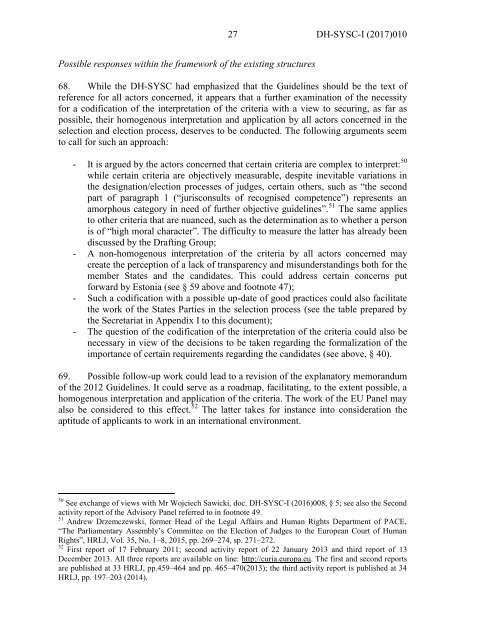Working document in view of the 3 DH-SYSC-I meeting
DH-SYSC-I(2017)010__EN
DH-SYSC-I(2017)010__EN
Create successful ePaper yourself
Turn your PDF publications into a flip-book with our unique Google optimized e-Paper software.
27<br />
<strong>DH</strong>-<strong>SYSC</strong>-I (2017)010<br />
Possible responses with<strong>in</strong> <strong>the</strong> framework <strong>of</strong> <strong>the</strong> exist<strong>in</strong>g structures<br />
68. While <strong>the</strong> <strong>DH</strong>-<strong>SYSC</strong> had emphasized that <strong>the</strong> Guidel<strong>in</strong>es should be <strong>the</strong> text <strong>of</strong><br />
reference for all actors concerned, it appears that a fur<strong>the</strong>r exam<strong>in</strong>ation <strong>of</strong> <strong>the</strong> necessity<br />
for a codification <strong>of</strong> <strong>the</strong> <strong>in</strong>terpretation <strong>of</strong> <strong>the</strong> criteria with a <strong>view</strong> to secur<strong>in</strong>g, as far as<br />
possible, <strong>the</strong>ir homogenous <strong>in</strong>terpretation and application by all actors concerned <strong>in</strong> <strong>the</strong><br />
selection and election process, deserves to be conducted. The follow<strong>in</strong>g arguments seem<br />
to call for such an approach:<br />
- It is argued by <strong>the</strong> actors concerned that certa<strong>in</strong> criteria are complex to <strong>in</strong>terpret: 50<br />
while certa<strong>in</strong> criteria are objectively measurable, despite <strong>in</strong>evitable variations <strong>in</strong><br />
<strong>the</strong> designation/election processes <strong>of</strong> judges, certa<strong>in</strong> o<strong>the</strong>rs, such as “<strong>the</strong> second<br />
part <strong>of</strong> paragraph 1 (“jurisconsults <strong>of</strong> recognised competence”) represents an<br />
amorphous category <strong>in</strong> need <strong>of</strong> fur<strong>the</strong>r objective guidel<strong>in</strong>es”. 51 The same applies<br />
to o<strong>the</strong>r criteria that are nuanced, such as <strong>the</strong> determ<strong>in</strong>ation as to whe<strong>the</strong>r a person<br />
is <strong>of</strong> “high moral character”. The difficulty to measure <strong>the</strong> latter has already been<br />
discussed by <strong>the</strong> Draft<strong>in</strong>g Group;<br />
- A non-homogenous <strong>in</strong>terpretation <strong>of</strong> <strong>the</strong> criteria by all actors concerned may<br />
create <strong>the</strong> perception <strong>of</strong> a lack <strong>of</strong> transparency and misunderstand<strong>in</strong>gs both for <strong>the</strong><br />
member States and <strong>the</strong> candidates. This could address certa<strong>in</strong> concerns put<br />
forward by Estonia (see § 59 above and footnote 47);<br />
- Such a codification with a possible up-date <strong>of</strong> good practices could also facilitate<br />
<strong>the</strong> work <strong>of</strong> <strong>the</strong> States Parties <strong>in</strong> <strong>the</strong> selection process (see <strong>the</strong> table prepared by<br />
<strong>the</strong> Secretariat <strong>in</strong> Appendix I to this <strong>document</strong>);<br />
- The question <strong>of</strong> <strong>the</strong> codification <strong>of</strong> <strong>the</strong> <strong>in</strong>terpretation <strong>of</strong> <strong>the</strong> criteria could also be<br />
necessary <strong>in</strong> <strong>view</strong> <strong>of</strong> <strong>the</strong> decisions to be taken regard<strong>in</strong>g <strong>the</strong> formalization <strong>of</strong> <strong>the</strong><br />
importance <strong>of</strong> certa<strong>in</strong> requirements regard<strong>in</strong>g <strong>the</strong> candidates (see above, § 40).<br />
69. Possible follow-up work could lead to a revision <strong>of</strong> <strong>the</strong> explanatory memorandum<br />
<strong>of</strong> <strong>the</strong> 2012 Guidel<strong>in</strong>es. It could serve as a roadmap, facilitat<strong>in</strong>g, to <strong>the</strong> extent possible, a<br />
homogenous <strong>in</strong>terpretation and application <strong>of</strong> <strong>the</strong> criteria. The work <strong>of</strong> <strong>the</strong> EU Panel may<br />
also be considered to this effect. 52 The latter takes for <strong>in</strong>stance <strong>in</strong>to consideration <strong>the</strong><br />
aptitude <strong>of</strong> applicants to work <strong>in</strong> an <strong>in</strong>ternational environment.<br />
50 See exchange <strong>of</strong> <strong>view</strong>s with Mr Wojciech Sawicki, doc. <strong>DH</strong>-<strong>SYSC</strong>-I (2016)008, § 5; see also <strong>the</strong> Second<br />
activity report <strong>of</strong> <strong>the</strong> Advisory Panel referred to <strong>in</strong> footnote 49.<br />
51 Andrew Drzemczewski, former Head <strong>of</strong> <strong>the</strong> Legal Affairs and Human Rights Department <strong>of</strong> PACE,<br />
“The Parliamentary Assembly’s Committee on <strong>the</strong> Election <strong>of</strong> Judges to <strong>the</strong> European Court <strong>of</strong> Human<br />
Rights”, HRLJ, Vol. 35, No. 1–8, 2015, pp. 269–274, sp. 271–272.<br />
52 First report <strong>of</strong> 17 February 2011; second activity report <strong>of</strong> 22 January 2013 and third report <strong>of</strong> 13<br />
December 2013. All three reports are available on l<strong>in</strong>e: http://curia.europa.eu. The first and second reports<br />
are published at 33 HRLJ, pp.459–464 and pp. 465–470(2013); <strong>the</strong> third activity report is published at 34<br />
HRLJ, pp. 197–203 (2014).



